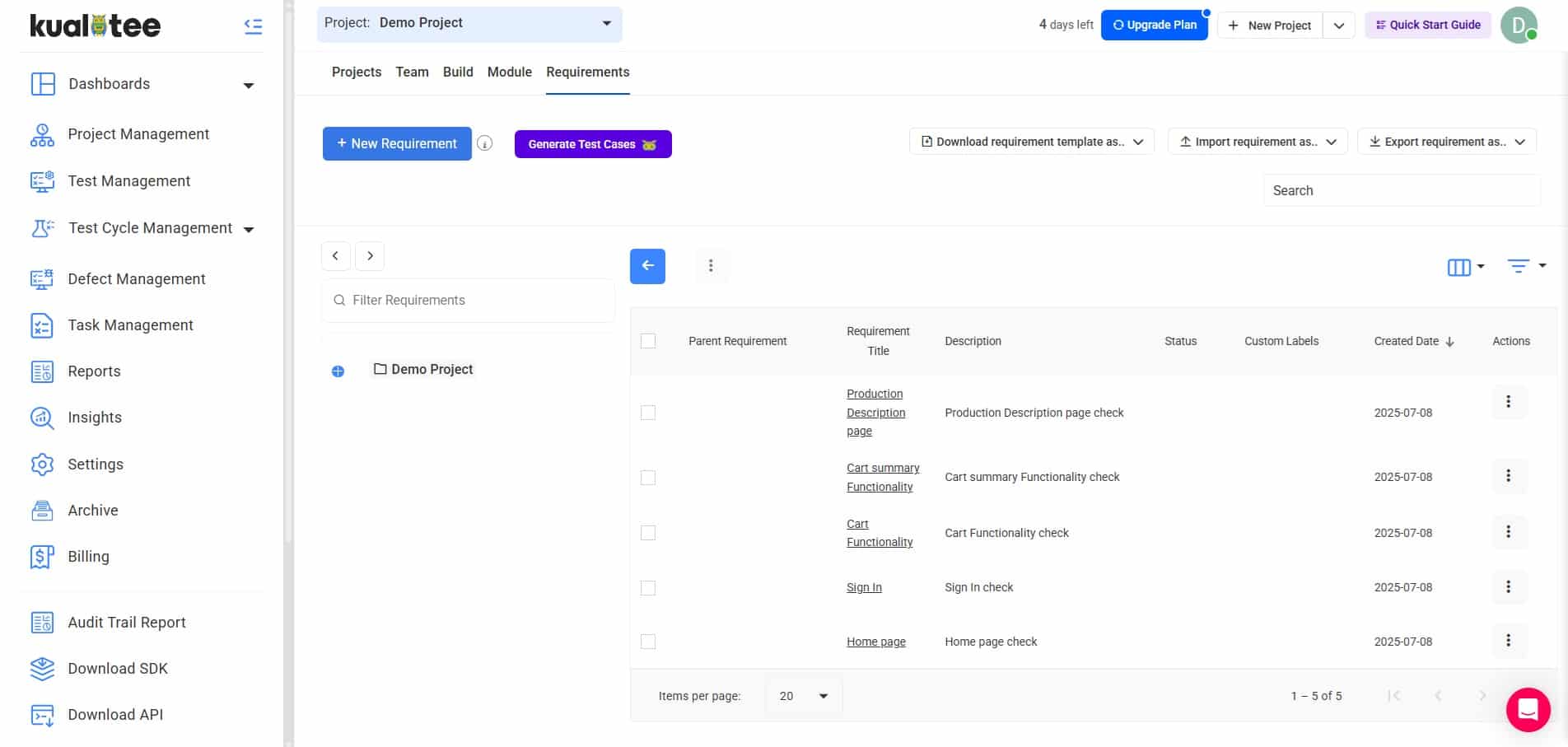Software applications are developed and tested while keeping certain requirements in mind. Juggling between expectations and ensuring software excellence can be a bit challenging.
If requirements are not met, it can lead to missed deadlines and business goals. So, for teams who aim to deliver high-quality applications. Using a requirement management tool is the only option.
It doesn’t matter if you’re new to software projects or you’re aiming to optimize an existing workflow. This guide has everything you need to know about requirement management tools. By the end, you’ll know how they can smooth your journey to smarter, more successful software development/testing.
What are Requirement Management Tools?
A requirement management tool is designed to help teams in the development and testing lifecycle. It makes it easier for them to gather, manage, trace, and track the needs and expectations for a software application.
Such a tool aims to keep the teams and the decision-makers aligned. This way, the final product meets the intended purpose and standards.
A point to be noted here is that while requirements sit at the heart of software development and testing workflows. They don’t usually exist in isolation.
Hence, modern requirement management tools allow smooth integration with your test management tool or quality assurance software. Some even provide everything in one place, so you don’t have to switch between apps. This enables linking requirements directly to test cases and various QA activities.
Do You Really Need a Requirement Management Tool?
If you’re a software tester or even a developer, then the short answer would be: YES!!
Relying on emails, spreadsheets, or scattered documents is way riskier than you might think. These things are prone to version confusion. And on top of that, the chances of losing context are also huge. A requirement management tool solves these pain points by:
- Providing a single source of truth for requirements.
- Reducing miscommunication and errors.
- Making things easier for audits, compliance, and documentation for regulated industries.
- Enabling transparency across teams. Especially in distributed ones.
- Increasing project predictability by actively managing scope changes.
Choosing the Right Requirement Management Tool
To start right is to make sure you finish strong. So, the first thing that you have to do is choose a good requirement management tool. When evaluating which tool to go with, consider the following factors:
- High usability: The tool of choice must allow easy onboarding. This will enable all team members to adopt it.
- Collaboration Capabilities: Real-time editing, feedback, and stakeholder engagement must be present.
- Traceability: You must be able to link requirements to tests, code, and other things.
- Integrations: The requirement manager must work smoothly with your existing test management software or quality assurance tool.
- Customizability: It should allow you to customize things to your project’s processes and unique workflow needs.
- Security & Compliance: Regulated industries like fintech and healthcare require this.
- Reporting & Analytics: There should be insights given by the tool. Ones that can help you look into progress, coverage, and bottlenecks.
Taking these factors into consideration, you can get a handful of requirement management tools to choose from.
However, consider trying out Kualitee. It has everything you need and is beginner-friendly as well. More on this later.
Steps to Use a Requirement Management Tool
Once a suitable tool is selected. Follow the steps below to use it effectively. Do note that these steps are compiled while keeping a broad list of tools in mind. So, they can generally be used on most requirement management tools on the internet.
Step # 1: Set Up Your Project
The first thing is to define the basic parameters of your project. Set its name. Define its scope. Mention who the key decision-makers are. And if possible, add those decision-makers to the project. That way, you can collaborate with them easily.
Next, it’s important to establish user roles and permissions. Set which team member sees what. This will enable better security and accountability.
Step # 2: Collect and Input Requirements
Gather everyone’s inputs. Business analysts, customers, end-users, technical lead, stakeholders, everyone. Consider them requirements for the software.
Then, add them to the tool. Make sure to keep them detailed so your team can easily understand. You can also attach supporting material along with the requirements. For example, images, documents, and mock-ups.
Step # 3: Organize and Categorize
After entering the requirements, group them. You can do that by considering feature, module, priority, release, or user role.
Another thing that can be done here is to make use of labels and tags. If navigation is hard, make folders too.
Step # 4: Collaborate and Review
Ask the decision-makers or reviewers whether the requirements you’ve added are fine. This will help spot any detail that you might’ve overlooked.
Also, run workshops by gathering the team and telling them what the expectations are in person. Furthermore, enable comment history in the tool so everyone can see what others think.
Step # 5: Trace Requirements
Once everyone is onboard, link the requirements to test cases. If you’re using a different tool for test management, you’ll have to do it in that.
On top of that, you can also map the requirements to user stories or code branches to ensure everything is implemented.
Step # 6: Manage Changes
Use the requirement management tool’s built-in version control. Track modifications if they are made by a team member.
Apart from this, notify the higher-ups about critical updates so they can review impacts and provide approvals.
Step # 7: Monitor Progress
Generate reports to visualize requirement completion. They can also include test coverage and defects. Usually, the tool will provide you with the insights needed to make these sorts of reports.
Lastly, use dashboards to identify bottlenecks and elements that are at risk. Then, convey them to the team so they can start fixing.
Common Pitfalls and How to Avoid Them
When making use of a requirement management tool, beginners face some common issues. Here’s what they are and how you can avoid them:
- Ignoring Stakeholder Requirements: Missing input can hinder development. Satisfaction might also be decreased. So, always consider the requirements provided by stakeholders.
- Overly Complex Tools: Choose a tool that matches your and the team’s skill level. A tool that is too complex to use can decrease productivity.
- Weak Traceability: Gaps in traceability undermine testing and compliance efforts. Make sure all the requirements are linked to test cases and other things.
- Neglecting Change Control: Failing to manage requirement changes can cause confusion. Defects also might get missed, causing project overruns.
- Resistance to Process: Without proper training, even the best tool will fail to deliver results. You and your team must know how to use it effectively.
Why We Recommend Kualitee for Managing Requirements
Kualitee stands out among other requirement management tools. That’s because it provides a complete workspace. One that unites requirements management, testing, and defect tracking.

Not just that, users can create test cases with AI and link them to requirements in mere seconds. All this within a single, intuitive interface. Other features include:
- End-to-End Visibility: Requirements and test cases. Along with defects are all interconnected. Traceability is seamless.
- Easy Audit: Kualitee allows you to instantly view all links between requirements and test cases. This makes audits and quality checks easier to carry out.
- Enhanced Collaboration: Real-time comments, role-based access, and notification systems are all present in Kualitee. Transparency and accountability are ensured.
- Integration Friendly: It allows integrations with various project management and CI/CD tools. Duplicate work is avoided.
- Detailed Reporting: Users gain actionable insights into requirements, coverage, and project health within the tool.
So, by using Kualitee, teams can make things easier for themselves. The cherry on top is that it was designed while keeping beginners in mind. So, it’s incredibly easy to use.
Final Thoughts
A requirement management tool is great for software development and testing. It makes it easier to ensure that the project goals are being adhered to. And quality standards are being met.
Furthermore, such a tool facilitates collaboration and traceability. It also minimizes the risks that are associated with using spreadsheets.
By following the outlined steps and choosing a good tool, such as Kualitee, teams can manage requirements better. They’ll be able to streamline their workflow, resulting in better software outcomes.














































